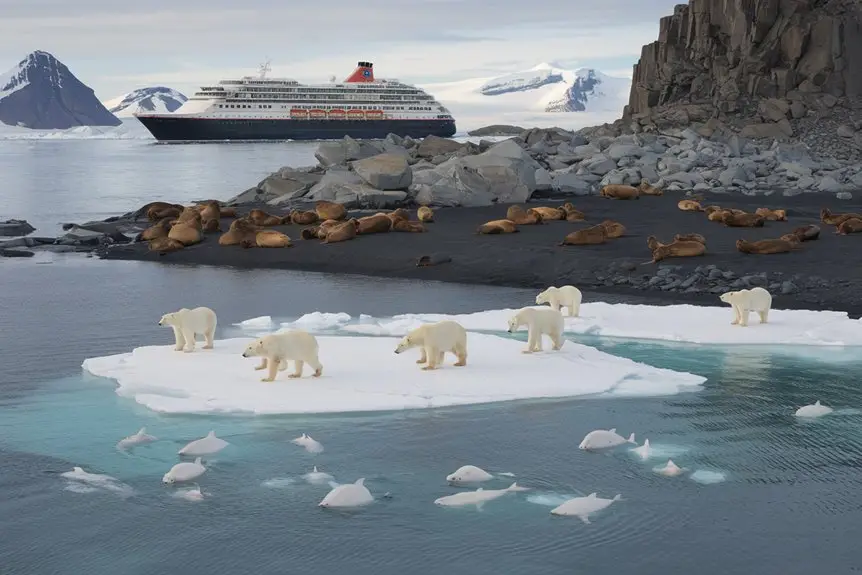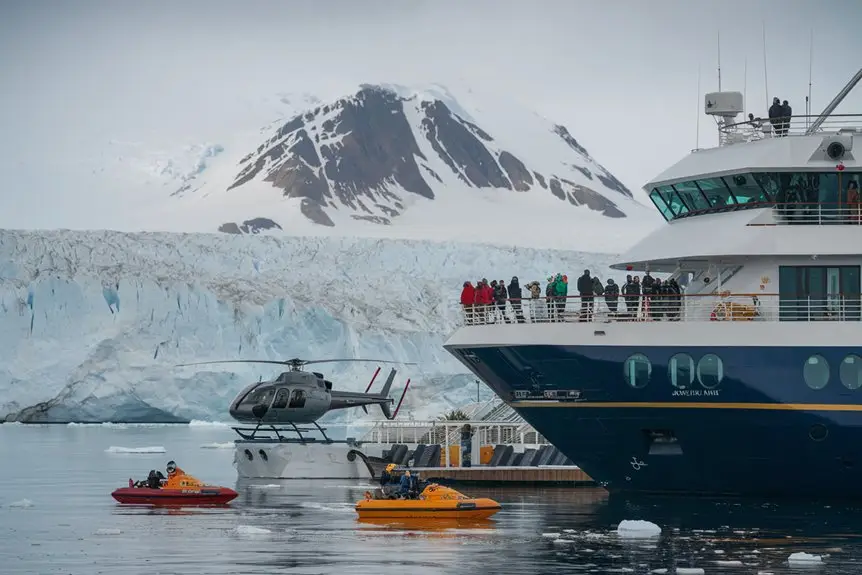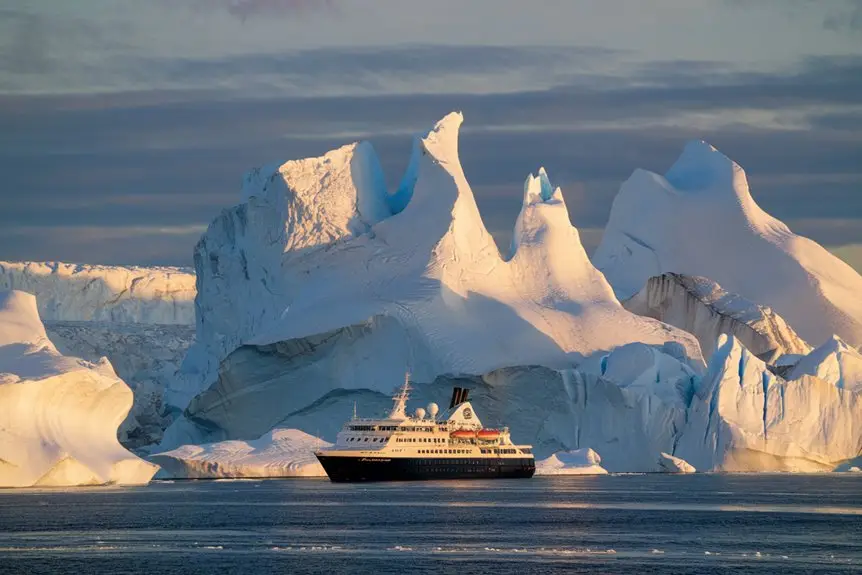You’ll discover Russia’s most northern region when visiting Franz Josef Land, situated 900 kilometres from the North Pole. You need to obtain a Russian double-entry visa before your journey. Pack Arctic-grade clothing to handle temperatures that range from 11°C in summer to -30°C in winter.
For other Russia Cruise destinations check out our Russia Cruise Ship Ports Guide page.
The best wildlife viewing occurs in July and August. You can spot polar bears and Arctic foxes from your expedition ship. You’ll see large seabird colonies during Zodiac boat excursions.
Your ship provides:
- Comfortable cabins
- Quality meals
- Arctic safety equipment
- Expert navigation systems
Professional guides take you to key historic locations:
- Cape Norway
- Cape Flora
These sites showcase the achievements of early polar explorers. The untouched Arctic landscape offers unique exploration opportunities across its vast wilderness.
Your Arctic cruise experience combines natural wonders, wildlife encounters and polar history in one remarkable journey.
🐧 Polar Cruise Enquiry 🐻❄️
Our team of polar travel specialists have personally explored both the Arctic and Antarctic regions – from tracking polar bears in Svalbard to kayaking with penguins off the Antarctic Peninsula. Let us find the right polar expedition cruise for you.
Location and Climate

Franz Josef Land sits in Russia’s northernmost region, 900 km from the North Pole and 1,200 km from the Kola Peninsula. The archipelago consists of 191 islands and covers an area 375 km east to west and 234 km north to south.
You’ll experience extreme seasonal variations throughout the year. You can observe the midnight sun from April to August. Summer temperatures reach a mild 11°C, while winter temperatures drop to -30°C.
December brings strong winds up to 60 km/h. You might notice temperature swings of up to 20°C within a single day.
You’ll find thick fog during summer months, though visibility typically extends to 15 km. The wettest weather occurs between July and September, with August recording the highest rainfall.
Getting Your Russian Visa

Russian Visa Requirements for Franz Josef Land
You need a Russian double-entry visa to visit Franz Josef Land. Standard visa-free cruise options don’t apply to these expeditions.
Your visa application requires:
- A valid passport (minimum six months beyond return date)
- A Letter of Invitation
- Medical insurance covering European Russia
- Completed pre-departure forms
- Passport copies
The visa costs are separate from your expedition fees, and you must pay them yourself.
Remember: The 72-hour visa-free rule for St. Petersburg cruises doesn’t work for Franz Josef Land.
You must get a full Russian visa, no matter how long you stay or what tour you book.
Wildlife Viewing Opportunities

Best wildlife viewing occurs in August and early September as sea ice thins. You can spot polar bears from the region’s 3,800-strong population – they often hunt near seal breathing holes or along the coastline.
You’ll see Arctic foxes moving between seabird nesting sites, and various seal species swimming in the waters.
Take a Zodiac boat through the British Channel and Austrian Strait for excellent viewing spots.
Visit Rubini Rock to watch thousands of kittiwakes and dovekies nesting in its massive seabird colonies.
Ship Facilities and Amenities

Your expedition ship to Franz Josef Land offers comfortable accommodation in various cabin types.
Standard cabins measure 226 square feet, whilst the Owner’s Suite provides 463 square feet of space. You get private bathroom facilities, a safe, fridge and adjustable heating in every cabin.
The main restaurant serves quality meals with French and Italian wines.
You can grab coffee around the clock at the self-service station. The bar stocks a full range of spirits including whisky, gin and rum.
You’ll find spacious lounges where you can attend daily educational talks, plus an outdoor area with a jacuzzi.
For your safety, the ship has a UK-licensed doctor on board and emergency evacuation systems.
The ice-strengthened hull lets you navigate Arctic waters securely.
When it’s time to explore, you can board Zodiac boats for shore visits.
Shore Excursions and Activities

Get close to Arctic wildlife through carefully planned routes around Franz Josef Land’s fjords and waters.
Your Zodiac boat trips take you near walruses, seals and whales in their natural habitat. Experienced guides help you spot polar bears on both ice and tundra landscapes.
Take your best wildlife photos by staying on your Zodiac’s sheltered side, keeping still, and following your guide’s safety tips for watching marine life.
Your small group adventures let you observe these magnificent creatures whilst maintaining safe, respectful distances.
Wildlife Viewing Expedition Routes
You’ll discover incredible Arctic wildlife along Franz Josef Land’s expertly planned viewing routes. The British Channel and Austrian Strait connect 192 islands, each offering unique wildlife encounters.
Your journey takes you to Cape Norway, where you’ll see steep cliffs, vast glaciers and significant historical landmarks. At Rubini Rock, you’ll watch seabirds nesting in their natural environment.
The flat tundra areas let you spot:
- Common eiders
- Purple sandpipers
- Arctic skuas
- Snow buntings
Along the coast, you’ll observe:
- Polar bears hunting
- Walruses resting on beaches
- Whales swimming in the Arctic waters
Each route gives you the best chances to see Arctic wildlife in their natural habitat. You’ll find clear paths and designated viewing spots throughout your expedition.
Polar Zodiac Cruising Tips
Getting around Franz Josef Land starts with Zodiac boat trips – small, sturdy inflatable vessels perfect for Arctic exploration.
You’ll get a briefing each day about where you’re heading and what to expect. Your Zodiac carries all crucial safety equipment, and you must wear the life jacket provided.
Your expert guide will take you through impressive fjords and ice-filled waters to see the Arctic’s best sights. You can spot polar bears swimming, walruses lounging on ice floes, and whales breaking the surface.
At Rubini Rock, you’ll find thousands of seabirds nesting on steep cliffs – bring your camera!
When you step onto land, trained guards keep watch for polar bears while you visit famous sites like Cape Norway and Cape Flora.
To make the most of your trip:
- Listen to your guide’s safety instructions
- Pack layers of warm clothing
- Be ready for quick weather changes
- Stay alert for wildlife sightings
The Arctic weather shifts quickly, so dress warmly and follow your guide’s advice for the best experience.
See what’s on offer from the Wrangel Island Cruise Ship Ports Guide for a different Russia Cruise destination.
Weather and Packing Requirements

Pack for dramatic temperature changes in Franz Josef Land. Summer temperatures average 2°C, while winters drop to -30°C. You might experience 20°C changes within one day.
You need:
- Arctic-grade layered clothing
- Thermal undergarments
- Warm socks
- Waterproof outer layers
Your cruise ship provides:
- Windproof parka
- Rubber boots for shore trips
Best visiting months are July and August, when temperatures stay between 3-7°C. Your clothing choices should handle both freezing conditions and milder summer weather.
Seasonal Temperature Expectations
Your guide to Franz Josef Land temperatures and cruise seasons:
Summer (July-August):
- You can expect daily highs of 11°C
- Temperatures stay stable between 6-11°C
- This is your best time to take a cruise
Spring (April-May):
- April starts cold at -9°C
- May warms up to 0°C
- You’ll see gradual warming throughout
Autumn (September-November):
- September begins at 7°C
- November drops to -3°C
- You’ll notice steady temperature decline
Winter (December-March):
- Temperatures drop to -30°C
- You’ll experience polar night from 19 October to 23 February
- Cruise ships can’t operate during this period
You must time your visit carefully.
Summer offers the most reliable conditions for your cruise, while winter makes travel impossible.
Pack according to your chosen season, as temperatures vary dramatically throughout the year.
Essential Cold Weather Gear
Pack your Arctic expedition gear in three key layers:
- Outer layer: Waterproof parka and trousers
- Middle layer: Fleece clothing
- Base layer: Thermal underwear
Your hands and feet need:
- Multiple pairs of thermal gloves
- Thick wool socks
- Waterproof, insulated boots
For shore trips, bring:
- Hiking poles
- Sunglasses with straps
- Waterproof bags for cameras
- Sunscreen
- Face cream
- Hand cream
For the ship:
- Casual evening clothes
- Eye mask for summer daylight
These items work together to keep you warm in Franz Josef Land’s varying temperatures.
Your boots and poles will help you move safely on rough ground, while your protective gear shields you from wind and water during Zodiac trips.
Remember: You can’t have too many dry gloves and socks in the Arctic.
Photography Tips and Techniques

Photographing Franz Josef Land: Essential Tips
Your Arctic photography needs two key elements: technical skill and creative eye. The summer sun stays up for 24 hours, giving you perfect lighting conditions with golden colours at midnight and dawn.
Equipment you need:
- Weather-sealed cameras
- Wide-angle lens for landscapes
- Telephoto lens for wildlife shots
- Multiple spare batteries
- Sturdy tripod
- Polarising filters
Key techniques:
- Keep your batteries warm in your pockets
- Use your tripod for every shot
- Add polarising filters to manage snow glare
- Take multiple exposures of the same scene
Best subjects to photograph:
- Polar bears
- Walruses
- Arctic seabirds
- Champ Island’s stone spheres
- Historic expedition sites
- Ice formations
Your photos will work best when you combine good gear with proper technique. The Arctic conditions challenge your equipment, but they reward you with stunning images.
Safety Guidelines and Protocols

Your expedition vessel is built to protect you in the Arctic environment. Every ship sailing to Franz Josef Land must meet strict safety requirements, including reinforced hulls and modern navigation equipment.
You must attend all safety briefings before your journey begins. These sessions teach you the emergency procedures you need to know. You need medical evacuation insurance for your trip, and you should tell the expedition team about any health conditions you have.
During Zodiac trips to shore, you must:
- Follow all crew instructions
- Be physically fit enough for safe landings
- Wear your safety equipment properly
The crew keeps you safe by:
- Talking to icebreakers regularly
- Checking ice conditions
- Using satellite systems for communication
- Maintaining emergency medical gear
Your safety depends on following these rules and working with the crew. The ship’s safety systems help you explore these remote waters with confidence, but you play an important role in keeping yourself and others safe.
Local Culture and History

Franz Josef Land’s story began in 1873 when the Austro-Hungarian North Pole Expedition discovered these Arctic islands.
You can explore this remote archipelago’s rich polar history, from early expedition bases to Soviet research outposts.
You’ll find key historical sites across the islands:
- Cape Norway and Cape Flora showcase preserved expedition camps
- Cape Tegetthoff displays explorer memorials
- Eira Harbour contains original expedition shelters
The Soviet Union took control of the islands in 1930.
Today, you can visit Franz Josef Land as part of Russia’s Arctic National Park, where scientists conduct research and small groups join guided tours.
The archipelago lets you step back into Arctic exploration history while experiencing its untouched polar environment.
You’ll walk the same paths as pioneering explorers and see how humans adapted to survive in these extreme conditions.
Frequently Asked Questions
Can I Send Postcards From the World’s Northernmost Post Office?
Yes, you can send postcards from Ny-Ålesund Post Office in Svalbard, Norway. This post office sits at 78°56′N and holds the genuine title of world’s northernmost postal service. You’ll find it’s a unique way to share your Arctic experience, though remember that Franz Josef Land’s facility makes an incorrect claim to this title.
What Cellular Network Coverage Is Available During the Cruise?
Cellular coverage is not available during your Franz Josef Land cruise. Your regular mobile phone service won’t work in these remote Arctic waters. You can stay connected through the ship’s satellite communication services instead.
Are There Age Restrictions or Physical Fitness Requirements for Passengers?
Age and Physical Requirements
You must be:
- 8 years or older
- At least 48 inches (122 cm) tall
- At least 64 pounds (29 kg) in weight
- Physically able to handle moderate activities
Your health matters because you’ll need to manage tasks like climbing in and out of Zodiac boats. The expedition includes activities that require basic fitness and mobility.
How Much Wildlife Interaction Is Permitted During Shore Landings?
Wildlife viewing rules during shore landings:
You must keep a safe distance from all animals at all times. Stay close to your guide and follow their instructions. You can watch wildlife only from the marked viewing areas – this protects both you and the animals.
Remember:
- Never walk towards wildlife
- Keep your voice low
- Stay with your group
- Use designated viewing spots
These simple guidelines help preserve the natural behaviour of the animals while giving you the best chance to observe them safely.
What Languages Do Expedition Guides Typically Speak During Tours?
Your expedition guides typically speak English as their main language during tours. Russian ranks as a popular second language among guides. You’ll also find many guides speak common European languages – French, German and Italian. This helps them connect better with diverse tour groups and makes your journey more accessible.
Thinking about something different? Check out the cruises leaving from Novaya Zemlya Cruise Ship Ports Guide.
🐧 Polar Cruise Enquiry 🐻❄️
Our team of polar travel specialists have personally explored both the Arctic and Antarctic regions – from tracking polar bears in Svalbard to kayaking with penguins off the Antarctic Peninsula. Let us find the right polar expedition cruise for you.
